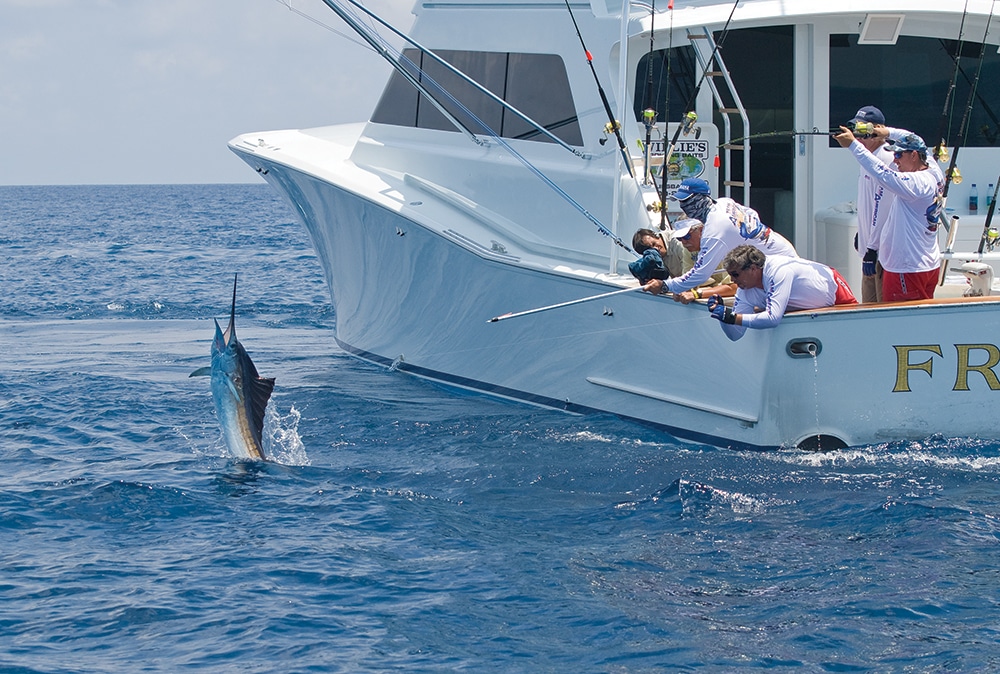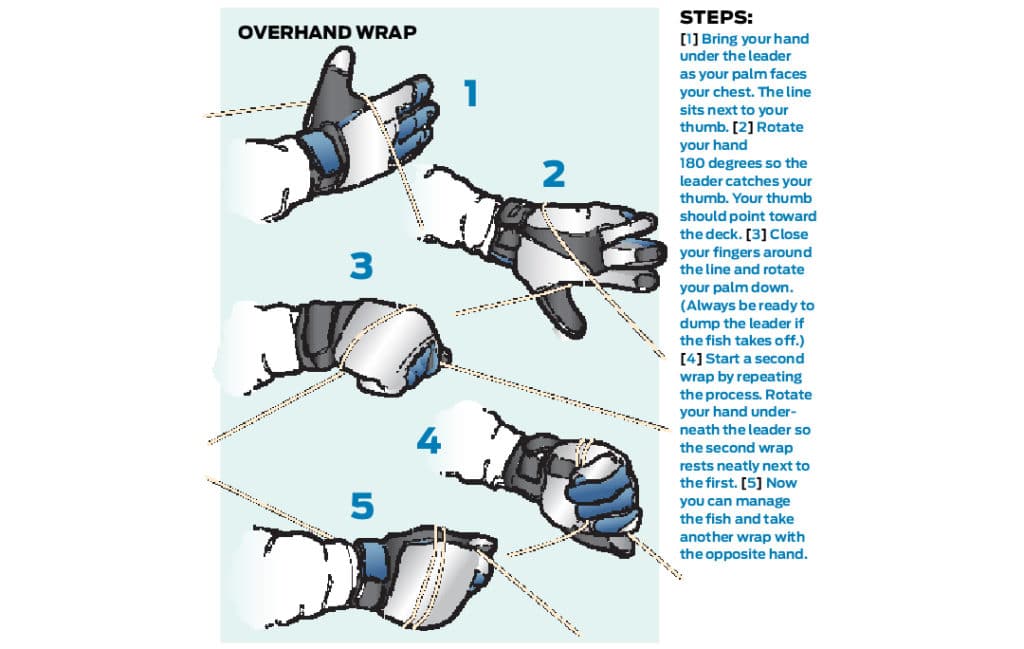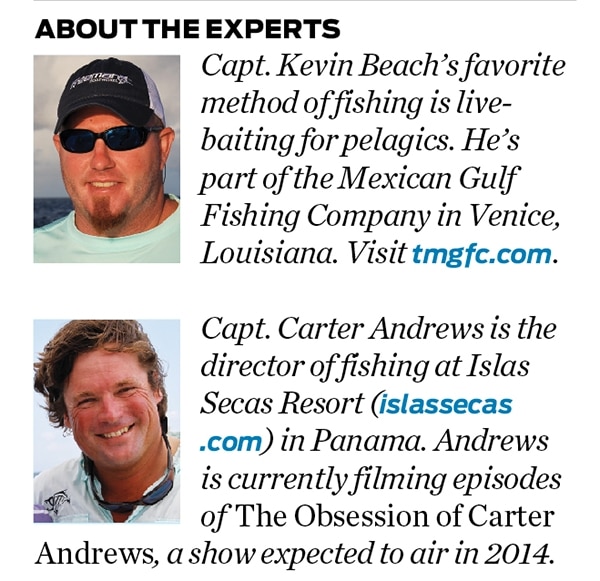
Leader fish main
Nobody ever sees it coming — mate Kyle Applefield sure didn’t. Last year, a blue marlin yanked him from the cockpit of the sport-fisher Blue Heaven off the coast of the Dominican Republic. A loose wrap caught his glove’s strap and tightened around his left hand as he leadered the fish. The fish surged, and he was pulled into the blue.
That’s how fast an offshore trip can turn into chaos, even for an experienced mate like Applefield.
“He made the proper wraps around his glove,” said Capt. Ed Thompson, who was running the boat. “The marlin wasn’t even all that big — about 110 pounds.”
Applefield kept his cool and recovered quickly. Treading water, he untangled his hand from the leader. Back on the boat, he successfully released the same billfish that had pulled him in earlier.
Cockpit mishaps happen. When targeting game fish offshore, proper preparation and techniques are vital to safely leader massive fish.
Cockpit Communication
When an amped-up billfish nears the boat, the captain, mate and angler must be on the same page.
“If you hesitate, you can put yourself in a bind,” says Kevin Beach, a charter captain out of Venice, Louisiana. “First and foremost, you want to be safe. The fish will dictate where the mate leaders the fish, but I like the action to happen in the port corner. That’s the best position for me to see what’s happening.”
Once the leader is in the mate’s hand, the angler’s job isn’t over. Capt. Carter Andrews, director of fishing at Isla Secas Lodge in Panama, agrees that the angler plays an import role.
“Ninety percent of the anglers we take fishing have never caught a tuna or marlin,” says Andrews. “We ask them to turn the clicker on, and then move the drag back to where we’ve marked it on the reel.”
Following the mate’s orders, the angler should reel in as much of the wind-on leader as possible, stopping only when the swivel reaches the rod tip.
“If the fish was fought with 25 pounds of drag, it’s safe to back off to about 10 pounds,” says Beach. “The angler has to be ready at all times. He needs to make sure the leader never wraps around the rod tip, or the shoulders, neck or feet of the leader man.”

Illustration by Dave Underwood
Wrap Artist
It’s important to understand, as leader man, how to properly wrap line around your gloved hands.
Wind-on leaders are used specifically so more line is cranked onto the reel and less is left in the bottom of the boat. Even still, often about 10 to 15 feet of leader remain to be handled. After the swivel, Andrews leaves about 12 feet of 200- or 300-pound mono leader for marlin or tunas.
Two common initial wraps are the overhand and backhand. Both Andrews and Beach prefer to use the overhand wrap.
“When leadering, try to keep your arms flexed and close to your body like shock absorbers,” says Beach.
The first motion is to pinch the leader with one hand and try to move toward the corner of the boat, away from the prop wash. “On our center-consoles, we always use the back quarter of the boat,” says Andrews. “We never leader from the bow, because we keep at least one engine running.”
Beach also keeps his boat in motion when his mate Jordan Ellis leaders fish.
“We’ll slowly circle our cat [hull]in reverse to keep the propellers away from the line and fish,” says Beach.
To start your first wrap, bring your other hand under the leader with your palm facing your chest. Grab the line by turning your hand toward the deck so the line catches on your thumb, and you can grasp the line with your fingers. Your palm should face down at this point. Make sure the line lies across your palm as you rotate your hand completely. That’s one wrap.
“We use overhand wraps only — no more than two wraps on one hand,” says Andrews. “Sometimes we use only one wrap, like with big sharks.”
For that second wrap, open your hand again. With the thumb pointed up and palm facing your chest, repeat the process. Make sure your second wrap lies cleanly next to the first. Now you can pull on the fish and begin the same process with the other hand. Practice makes perfect, so start leadering any offshore fish you catch.
“Most important, don’t do anything stupid,” says Beach. “Always be able to release the leader if necessary. Expect to have to ‘dump’ the leader, especially when you try that first wrap.”
Cut Loose
So what’s the best way to release a fish once it’s leadered?
First off, the leader man should always have on a pair of wiring gloves. Second, he ought to wear a pair of nonskid shoes and have a line-cutting device on his belt. Those line cutters are a perfect tool to snip the leader near the hook for species such as sailfish, marlin and sharks.

“If you use a tag stick, you can add a line cutter to the end of that too,” says Andrews. “That extra reach is important.” Companies like Melton Tackle offer tag sticks that feature a release knife.
There’s much less to consider if you want to keep the fish. For tuna, wahoo, mackerel and dolphin, gaff the fish in a spot that misses the meat. “For our wahoo caught on a short leader,” says Beach, “we do one wrap, and then stick ’em with the gaff.”
Another option is to pop off the fish without using a line cutter or gaff. “You can hold onto the leader,” says Andrews, “so that when the fish surges, it pops on its own.”
A snelled hook is easier to pop, especially after a long battle roughs up the leader. A crimped hook is harder to break off, admits Andrews.
“I have no problem breaking off a marlin 15 feet from the boat,” says Andrews. “Anglers have a responsibility to fish that aren’t going to be kept. Don’t play hero. Don’t beat up the fish at the side of the boat. The fish is more important than a photo.”








